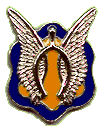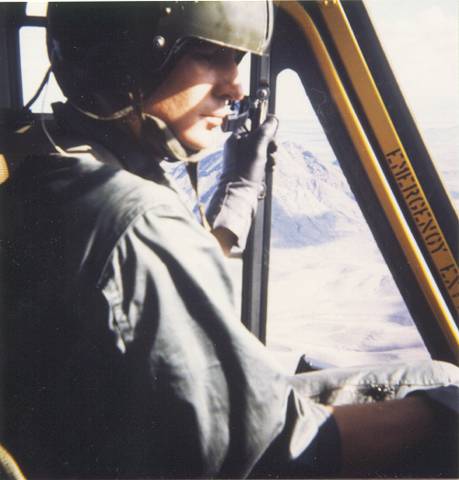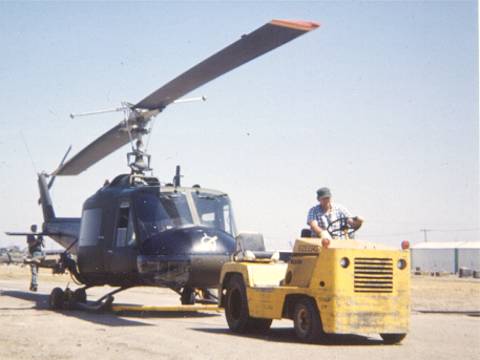

ROBERT N STEINBRUNN'S LETTER
March 18, 1999
Dear Cavalrymen,
The time has finally presented itself wherein I can now relate and set down the true facts concerning that dramatic and unforgettable episode in American military history known as The Saga of Captain Charles Rayl and the 30-Foot Tobacco Streak! Previously the domain of native folklore and legend, this story is true nonetheless, and if any gentleman should call my veracity into question, I may reply that I was there, I saw it, I was able to photographically record it, and I remain astounded to this day.
The story unfolds thusly: on 16 Mar 67 I was graduated from the U S. Army Aviation School at Fort Rucker, Alabama. While the first alphabetical half of my class went immediately to the Republic of Vietnam as replacement pilots, I was fortunate enough to be assigned to Alpha Troop, 7th Squadron, 17th Air Cavalry (Regiment) at Fort Knox Kentucky, for six months as a gunship pilot. This assignment involved the formation of a new reconnaissance unit (the 3rd and 7th Squadrons of the 17th) and the development of viable combat tactics. During this period we honed the skills necessary to function as the future eyes and ears of the 4th Infantry Division which was based at Camp Enari, Pleiku, Central Highlands, The Republic of Vietnam.
In due time the training period was over and it was time to go to war. The aircraft being considered necessary for deployment, we were assigned a ferry mission which required flying the helicopters, en masse, from Fort Knox to Sharpe Army Depot in Stockton, California. .

Warrant Officer Robert N. Steinbrunn
on the ramp at Fort Campbell during the mass ferry flight on 29
Aug 67
Accordingly, on 27 Aug 67 1 was assigned to a Bell UH-1C, # 66-648, for the first day's flight. This formation departed Ft. Knox for Ft. Campbell, KY (1.O flight hours enroute), to Naval Air Station Memphis (1.0 enroute), to Texarkana (2.0 enroute), to NAS Dallas (1.5 enroute), for a total of 5.5 flight hours.
My aircraft developed fuel boost pump trouble there, and since I had relatives in Dallas, I volunteered to stay with it for the two-day period of repair. On 29 Aug 67, I was assigned to UH-1C #66-727, and departed in it from NAS Dallas for Dyess Air Force Base in Abilene, Texas (1.5 enroute), to Webb AFB \par in Biq Spring, Texas (1.0 enroute), to Carlsbad, New Mexico (1.5 enroute), to Fort Bliss, El Paso, Texas (1.3 enroute), for a total of 5.3 fight hours.
On 30 Aug 67 I was given a new aircraft commander, one Captain Charles Rayl, of the much dreaded yet little known Airborne persuasion. Now, Charlie came to us at Ft. Knox with some sort of a reputation: his fatigues crackled as he walked, his steel helmet had the double airborne chin strap, and his boots had this dazzling shine. His demeanor was that of the Roman emperors and he projected an aura of imperiousness. In short, there was little to choose between Charley and General of the Army Douglas MacArthur. This was intimidation at its finest if you were a humble Warrant officer WO-1.
Charlie and I departed, within the formation, from Ft. Bliss for Fort Huachucha (1. 7 enroute), to Phoenix Arizona (1.3 enroute ), to Marine Corps Air Station Yuma, Arizona (1.3 enroute), to Palm Springs, California (1.2 enroute), to Bakersfield, California (1.8 enroute), for a total of 7.3 fight hours.
During this lengthy, monotonous, and tedious flight segment over the arid wasteland of the Great American Southwest, Charlie occupied the left seat the entire time and was content to fly just a little, offer sagacious advice on animal husbandry (his degree, if memory serves), and to chew what any sentient observer would consider an enormous amount of Beech Nut tobacco.
Charlie found it convenient to slide his door window down to the open position and to expectorate the remains of his "cud" out the port side of the aircraft where it was immediately influenced by the airstream and the immutable laws of physics.

Captain Charles Rayl
over the desert of New Mexico demonstrating his ability to fly
and chew at the same time.
We departed Bakersfield on 31 Aug 67 and flew a mere 1.5 hours to Sharpe Army Depot, Stockton, California, which was our final destination. The aircraft would then go through a preservation process which specified the draining of all fuel and fluids and the cocooning of the exterior with a spray-on latex The aircraft would then be loaded onboard a former World War II escort carrier, the U.S.S. Breton, AVG-23 (formerly CVE-23), for the trip across the Pacific Ocean.
After shutting the aircraft down, filling out all required forms and records, we prepared to sign the ship over to the depot authorities. With their accumulated years of wisdom, however, they were not going to sign for any aircraft they had not inspected with a ten-power glass. They then proceeded to do just that.
Whilst I was sitting in the right pilot seat finalizing my aircraft logbook entries, I was startled by numerous howls of dismay from the left side of the aircraft. The authorities had, without the aid of their 10-power glass, discerned a large, brown, messy, unsightly, festering, totally uncamouflaged, to say nothing of unauthorized, 30 foot streak of expectorant bearing unmistakable signs of Beech Nut tobacco!
At this juncture I executed the proper and expected action of the newly- fledged Warrant: I slid the armor plate of my seat to the forward position and placed into action all I had learned regarding escape and evasion.
The depot major conducting the inspection was not fooled, and regarding me with a baleful eye, demanded an explanation. Falling back on my training, I expressed ignorance, and being a Warrant Officer, knew that no one would regard me as possessing an iota of responsibility.
The action then shifted to the left side of the aircraft where Charlie was strategically placed to fend off all enquiries regarding the defacing of government property. I doubt that any U.S. Supreme Court case was more ably pled. Not being a party to these proceedings, and feeling that Charlie would soon be led off in restraints to Leavenworth military prison, I secured my personal belongings and flight gear and boarded the waiting bus forthwith. I did find time to shed a small tear in Charlie's memory, and then braced myself to facing life without him.
.
UH-1C #66-727
being towed to the car wash at Sharpe Army Depot, Stocken, CA, on
331 Aug 67.
The bus took all the aircrew over to San Francisco International Airport where a chartered Boeing 727 was awaiting us, eager to return us to Ft. Knox, Kentucky.
You may imagine my surprise as, when I took my assigned seat, I found myself in the right seat of a two-seat row, the left seat, naturally, being occupied by Capt. Charles Rayl!
Well, sir, cast your thoughts back to those memorable days when we were so very young. In my case, being only 20 years old but thinking I had both the wisdom of Solomon and the measure of the Army (being in it, by this time, all of about 18 months), I found myself speechless and without a clue as I perceived Charlie in coat and tie wearing a grin two Texas counties wide. He was just as free and unencumbered as a bird. No shackles were to be found on his wrists or ankles, nor any Military Police in attendance, escorting him to his place of incarceration.
Some time passed on this return flight before I mustered the courage to make suitable inquiries as to his remarkable escape from the clutches of the authorities. He replied, somewhat condescendingly, and with some little surprise that any other outcome could possibly be entertained, that he was able to inject a little military discipline into those slack depot troops, had them lined up, dressed right, and covered down, and was then in a position to instruct them in the proper care, maintenance, and cleaning of "combat-damaged" government property!
I then realized I was in the presence of greatness and had much to learn regarding mastery of the tactical situation.
To this day, I chuckle at the adventures we had, I marvel at the pageantry and poignancy of serving in the military in those turbulent national times, the feelings of pride of having done it and done it well., at having served with the cream and flower of American youth, at having written, in a very small and personal way, history, that no one may take away or eradicate, at having learned that the team is more important than the individual, and, at last, at having become a man.
To all those of the cavalry who are present and accounted for, and who may perhaps, be reading these words, and to those of us who have "gone west," I have two things to say: I count myself fortunate, indeed, to have stood amongst you, and, for the remainder of my life, gentlemen, I salute you!
Written just very slightly tongue-in-cheek, but with the very highest of regards, and scribed 32 years and 13,000 flight hours after-the-fact, and still feeling honored to have served with such men, and possessing a sense of awe at what they accomplished, I remain, sincerely and very truly yours,
Robert N. Steinbrunn
Warrant Officer WO-1
A/7/17 Cav
Ruthless Tornado White 23 bravo